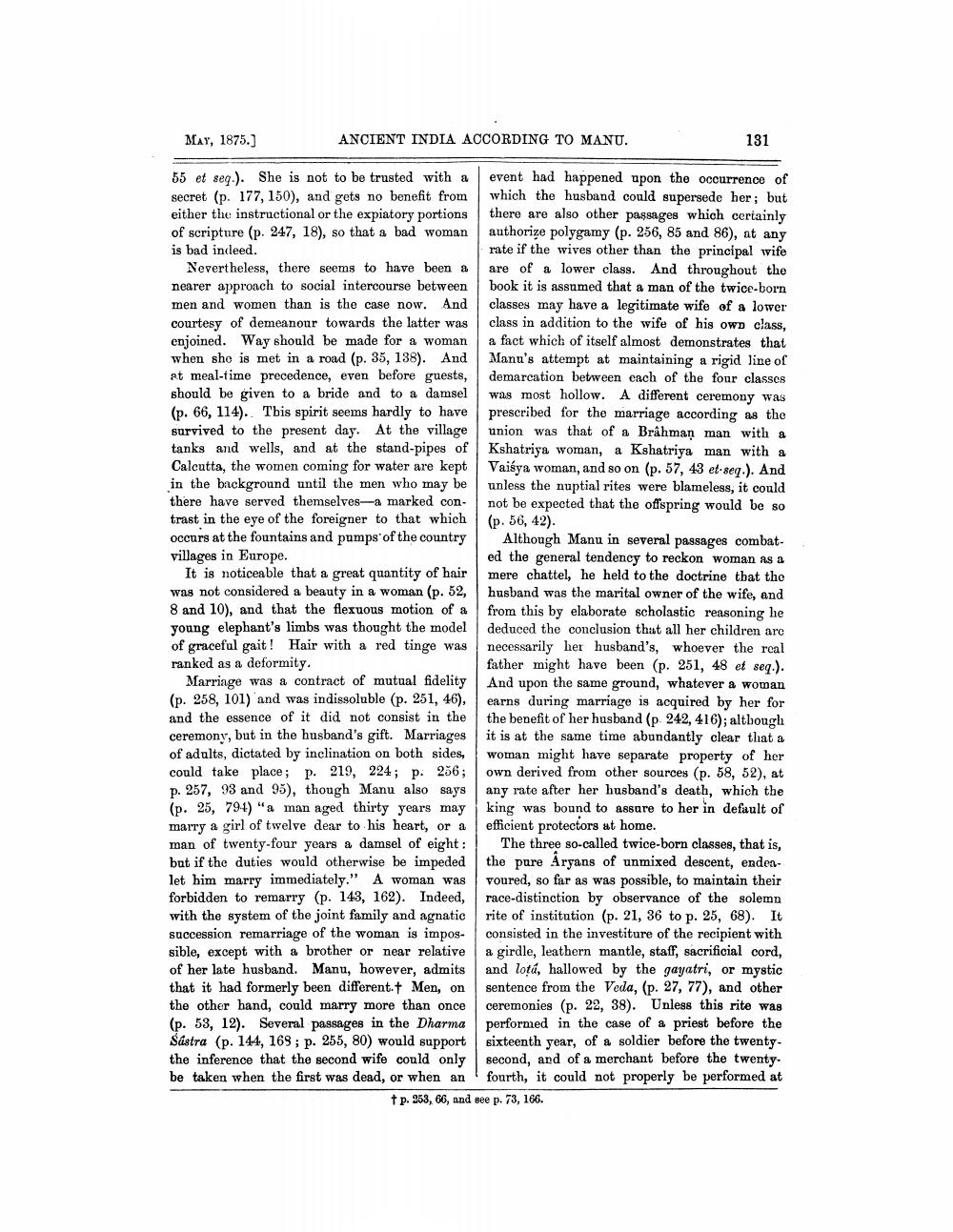________________
ANCIENT INDIA ACCORDING TO MANU.
MAY, 1875.]
55 et seq.). She is not to be trusted with a secret (p. 177, 150), and gets no benefit from either the instructional or the expiatory portions of scripture (p. 247, 18), so that a bad woman is bad indeed.
131
event had happened upon the occurrence of which the husband could supersede her; but there are also other passages which certainly authorize polygamy (p. 256, 85 and 86), at any rate if the wives other than the principal wife are of a lower class. And throughout the book it is assumed that a man of the twice-born classes may have a legitimate wife of a lower class in addition to the wife of his own class, a fact which of itself almost demonstrates that Manu's attempt at maintaining a rigid line of demarcation between each of the four classes was most hollow. A different ceremony was prescribed for the marriage according as the union was that of a Brâhman man with a Kshatriya woman, a Kshatriya man with a Vaisya woman, and so on (p. 57, 43 et seq.). And unless the nuptial rites were blameless, it could not be expected that the offspring would be so (p. 56, 42).
Nevertheless, there seems to have been a nearer approach to social intercourse between men and women than is the case now. And courtesy of demeanour towards the latter was enjoined. Way should be made for a woman when she is met in a road (p. 35, 138). And at meal-time precedence, even before guests, should be given to a bride and to a damsel (p. 66, 114). This spirit seems hardly to have survived to the present day. At the village tanks and wells, and at the stand-pipes of Calcutta, the women coming for water are kept in the background until the men who may be there have served themselves-a marked contrast in the eye of the foreigner to that which occurs at the fountains and pumps of the country villages in Europe.
It is noticeable that a great quantity of hair was not considered a beauty in a woman (p. 52, 8 and 10), and that the flexuous motion of a young elephant's limbs was thought the model of graceful gait! Hair with a red tinge was ranked as a deformity.
Marriage was a contract of mutual fidelity (p. 258, 101) and was indissoluble (p. 251, 46), and the essence of it did not consist in the ceremony, but in the husband's gift. Marriages of adults, dictated by inclination on both sides, could take place; p. 219, 224; p. 256; p. 257, 93 and 95), though Manu also says (p. 25, 794) "a man aged thirty years may marry a girl of twelve dear to his heart, or a man of twenty-four years a damsel of eight: but if the duties would otherwise be impeded let him marry immediately." A woman was forbidden to remarry (p. 143, 162). Indeed, with the system of the joint family and agnatic succession remarriage of the woman is impossible, except with a brother or near relative of her late husband. Manu, however, admits that it had formerly been different.† Men, on the other hand, could marry more than once (p. 53, 12). Several passages in the Dharma Sastra (p. 144, 169; p. 255, 80) would support the inference that the second wife could only be taken when the first was dead, or when an † p. 253, 66, and see p. 73, 166.
Although Manu in several passages combated the general tendency to reckon woman as a mere chattel, he held to the doctrine that the husband was the marital owner of the wife, and from this by elaborate scholastic reasoning he deduced the conclusion that all her children are necessarily her husband's, whoever the real father might have been (p. 251, 48 et seq.). And upon the same ground, whatever a woman earns during marriage is acquired by her for the benefit of her husband (p. 242, 416); although it is at the same time abundantly clear that a woman might have separate property of her own derived from other sources (p. 58, 52), at any rate after her husband's death, which the king was bound to assure to her in default of efficient protectors at home.
The three so-called twice-born classes, that is, the pure Aryans of unmixed descent, endeavoured, so far as was possible, to maintain their race-distinction by observance of the solemn rite of institution (p. 21, 36 to p. 25, 68). It consisted in the investiture of the recipient with a girdle, leathern mantle, staff, sacrificial cord, and lotá, hallowed by the gayatri, or mystic sentence from the Veda, (p. 27, 77), and other ceremonies (p. 22, 38). Unless this rite was performed in the case of a priest before the sixteenth year, of a soldier before the twentysecond, and of a merchant before the twentyfourth, it could not properly be performed at




